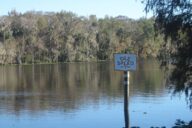New Zealand Mudsnail
Daniel Kelly | Fondriest Environmental
New Zealand Mudsnails originated from the island nation and reproduce most commonly by cloning themselves in a process called parthenogenesis. In fact, most that inhabit waters in the United States are female and genetically identical to one another. Their latin name is Potamopyrgus antipodarum and they can be found in all of the Great Lakes and water bodies throughout the northwestern United States.
Because of this flexibility in reproduction that only females have, the snails spread rapidly and take up large areas with ease. Mudsnails are made more robust because of their diet, which consists mostly of bottom algae and small bits of waste and debris. Their inhabited zones can reach thousands of square meters in size and are located in rivers, streams and lakes alike. New Zealand Mudsnails have no natural predators outside of New Zealand, but are kept in check there by small worm parasites. Several fish species prey on them as well.
The snails are small, have few distinctive markings and seal themselves up to avoid drying out, making it possible for them to survive for days out of water. These stealthy adaptations allow them to be transported by boaters, anglers and other unsuspecting water enthusiasts in ship ballast water, wading boots or on poorly rinsed boating gear.
Prevent Its Spread
Because New Zealand Mudsnails need carriers to spread, it is important to keep boats and gear clean. This can be done by rinsing equipment before transferring to another waterway. They can also be soaked in warm water or sprayed with Clorox brand 409 Cleaner that has an ammonium compound that kills them. A good practice is to let sterilized pieces of gear dry completely before re-use. Snail populations should also be reported to local wildlife officials.
Scientists are investigating the use of trematode parasites to control the snails’ spread. The flatworms are known to use New Zealand Mudsnails as hosts, manipulating their behavior so that they attach to surface rocks and become more vulnerable to water fowl. This type of control method using natural predators is known as classical biological control.
Sources:
- https://wdfw.wa.gov/species-habitats/invasive/potamopyrgus-antipodarum
- https://wildlife.utah.gov/pdf/fes/pdf/volume_19-2.pdf
- http://www.kingcounty.gov/environment/animalsAndPlants/biodiversity/threats/Invasives/Mudsnails.aspx
- http://www.dnr.state.mn.us/invasives/aquaticanimals/nz_mudsnail/index.html
- http://kdwpt.state.ks.us/news/Fishing/Aquatic-Nuisance-Species/Aquatic-Nuisance-Species-List/New-Zealand-mudsnail
- http://cisr.ucr.edu/new_zealand_mud_snail.html
- http://rivrlab.msi.ucsb.edu/invasive-species/new-zealand-mud-snail
- https://www.seagrant.wisc.edu/our-work/focus-areas/ais/invasive-species/invasive-species-fact-sheets/mollusks/new-zealand-mud-snail/










